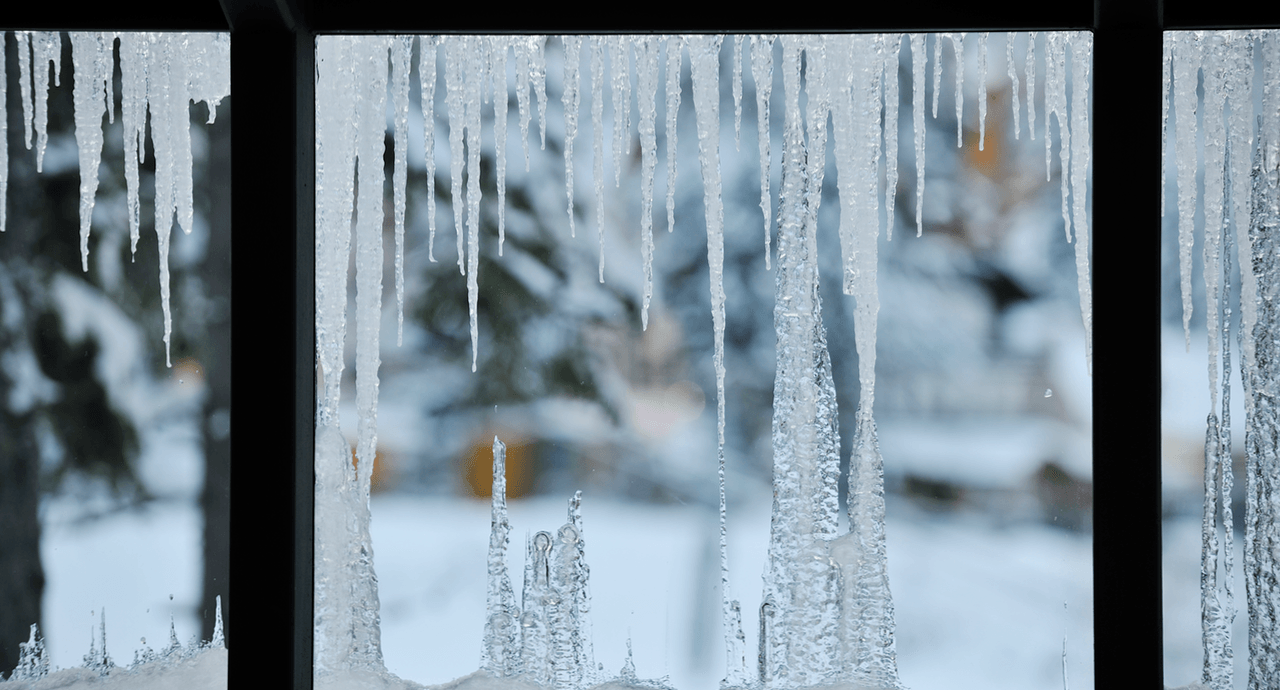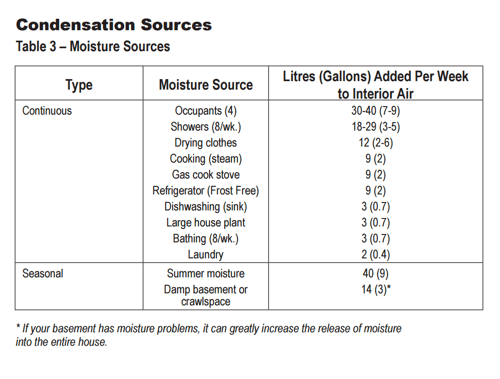
As the seasons change, one of the biggest challenges that homeowners face is understanding the humidity inside their new home. New homes have freshly poured concrete that needs time to cure. The wood products used to build your home also expel moisture into the air. This increases the humidity inside the home and is difficult to control over the first year or two. Don’t worry—the condensation on windows will decrease as years pass. In the meantime, we’ve created this quick guide to understanding the humidity levels in your new home throughout the year.
To visualize what is happening inside your home, here are two scenarios:
1. It is a hot summer day. You run inside to grab an ice cold beverage. You step outside and the glass immediately forms condensation. You wipe it up, and within a minute or two, it’s back.
2. It is -18 degrees outside. You grab a hot cup of coffee and run to your cold vehicle. Within minutes, your windshield ices up on the inside (if you run out with wet hair, it gets even worse).
Window condensation is always a humidity issue. We understand that as a homeowner, window condensation can be very frustrating. While there is often very little that can be done structurally, your builder can provide advice on ways to mitigate the problem. Here are a few pointers to help you manage humidity in your new home during the first few years
Each person and regular activity in your home adds more humidity into the air. To show you just how much moisture is added to the air inside your home by normal activities, here is a chart courtesy of the City of Edmonton’s Condensation Concerns resource:
Suggestions for Humidity Control
The ideal humidity in the home is about 35%. In the deep cold of winter, the humidity may need to be dropped down as low as 15% temporarily if condensation on windows becomes an issue. Once the weather moderates, the humidity levels should be increased to prevent permanent damage to the floors and cabinets.
Determining the actual humidity level in your home requires a hygrometer. A hygrometer reads the humidity levels and can help you determine what adjustments are required to reach the optimal humidity.
New homes have a naturally higher humidity because the components that were used to build your home are still curing, making it difficult to maintain a 35% humidity level. By the second year, humidity levels are easier to control and by the third or fourth year, much of the window condensation/high humidity levels will be gone.
Over the short term, there are some steps you can take that may help to ease the high humidity levels in your home. The following information comes from All Weather Windows, with a few extra suggestions as they relate to our homes:
- A new home will typically expel 500 to 600 gallons of water in the first year and a half, so it is difficult to reduce condensation during this time.
- It is normal to have about 1″ of moisture on a sealed window unit in the middle of winter.
- Do not shut off your humidifier. Turning the humidity down to low prior to a cold snap – up to a week in advance – is helpful. Remember to turn the humidifier back up after it warms up.
- Sliding windows will typically have more condensation on the fixed portion due to the glass being positioned further to the exterior than the interior.
- Ventilation is the most effective means to remove moisture from your home. By exchanging some of the drier outdoor winter air for warm humid interior air, the moisture level inside the house will be reduced.
- Open a door or window for short periods to allow moisture to escape.
- Go outside and be sure the “fresh air intake” screen is not frosted over. Check the furnace and HWT pipes to be sure there is no snow accumulation near the pipes and check the screens inside the intake to be sure these have not frosted over. If any of the screens are completely frosted over, there will be no fresh air getting into your home and the furnace and HWT may shut down completely. If they are partly frosted over, there may be increased humidity in the home. Ensure the filter inside the HRV unit is clean to allow proper air movement.
- Gas appliances produce moisture from combustion. Cooking adds even more moisture so be sure to run your kitchen fan while cooking. Vent the kitchen fan directly to the outside to achieve the desired effect. NOTE: Your Pacesetter home does vent directly outside. Hood fans should run for a minimum of 15 minutes after cooking is done.
- Showers are a high source of moisture. Keep bathroom doors shut and run the exhaust fan to eliminate moisture. Ensure you leave your fan on for a minimum of 15 minutes after you shower (or at least an hour if you’re taking a bath) to allow the humid air to be removed to the outside.
- Clothes dryers should be vented to the outside. Hanging up wet clothes to dry inside your home can add significant moisture to your home.
- Free air circulation is important. Do not cover hot or cold air registers with furniture or appliances. Leave bedroom and bathroom doors open.
- Keep the temperature of all rooms at a minimum of 10C (50F), even if unoccupied. Condensation will occur in an unheated room. (NOTE: Pacesetter Homes does not recommend less than 16C for a winter temperature setting.)
- Condensation will typically be greater on the second floor since warm air rises, and the upper floors are exposed to greater winds cooling the glass.
- Wipe up any tracked-in snow before it melts and evaporates.
- Wet floors from mopping can add large amounts of moisture. Run exhaust fans (bathroom and kitchens) while floors are wet. Avoid washing floors on extremely cold days. ADDED SUGGESTION: Running the HRV fan in extreme cold may help expel some of the humidity even if you are not washing floors.
- Most builders (like us) install a fresh air intake into the cold air return duct of the heating system. Make sure that the intake damper is open and that there are no obstructions to prevent airflow. If you do not have a fresh air intake, have one installed.
- Drapes and blinds should be left open during the daytime. At night, raise blinds at least 4″ up (preferably 6-8″) off the frame to allow air to flow against the glass.
How to Identify a Non-Humidity Problem
There are a few things you should look for to know if you have a humidity issue in your home:
1. The condensation is between the 2 panes of a sealed window unit.
2. The HRV unit lights are not on.
3. The duct leading to the HRV (large pipe attached to the HRV unit) is covered with condensation.

